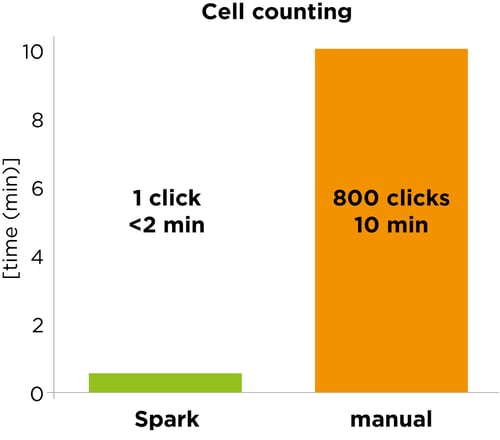Keywords:
Tecan uses cookies to improve our website. By continuing to browse our website, you accept our cookie policy.
Tecan uses cookies to improve our website. By continuing to browse our website, you accept our cookie policy.

Keywords:
By Siegfried Sasshofer
The hemocytometer has been around for 140 years. It’s an easy, reliable, and trusty tool for all kinds of cell counting applications. It’s beautiful and simple. But measuring the well-being of your cells one click at a time is slow and tedious, and can be near impossible for adherent cells. Shouldn’t you be doing something else with your time?

Monitoring cell viability is a matter of life and death – for your sanity as well as your experiments.
Give them too much food and they die. Not enough food…they die. Bad water…they die. If your cells aren’t healthy your experiments won’t work. You need to monitor culture conditions, nurture your cells, and confirm that they’re healthy before you start any experiments. Then you have to wash the chamber, refill it, set up and focus the microscope to count the next sample. Cell culture QC is critical, and it’s never-ending.
Cell culture doesn’t end at the incubator. As soon as you take your cells out of the incubator they begin to cool and gas levels shift. They become stressed and gene expression changes. Behavioral and morphological changes can add to the challenge of distinguishing live from dead cells. The longer you can keep your cells in their favorite culture environment the easier your counting will be.
Also like goldfish, if your cells are happy, they’ll just keep growing until they fill the fishbowl, then they stop. Maybe you’re passaging your cells so you want them to be in log-phase. You need to catch them before growth inhibition or aggregation sets in, especially for adherent cells and sensitive or precious primary cells. But if your culture has too few cells they may not proliferate.
Or maybe confluence is just what you need. It’s a critical factor for differentiation of endoderm, for example. Reaching just the right level of confluence is also important in studies of endothelia and other structural tissues, and in investigating cell-cell interactions.
Regardless of your purpose, cell density in culture can change gene expression and cell behavior. Your confluence measurements help you ensure the right phenotype and help you guide your cells to the most physiologically relevant conditions for your experiment. Accurate and consistent confluence determination also contributes to reproducibility across experiments.
But accurate measurement of confluence is focused and often tiring work. Ensuring consistency with your colleagues requires particular care. And to catch your cells at just the right point for your experiments you have to be there when they’re ready, any time of the day and any day of the week.
Cell counting assays are yielding exciting new insights into the tremendous complexity in cellular responses to all kinds of visitors – small molecules, natural products, peptides, nucleic acids, and other biomolecules. Determining whether those agents are friend or foe reveals important insights into contributors to growth, disease, infection, healing, mutation, and contamination. End-point assays are a cornerstone of such studies. Accurate viability, proliferation, and cytotoxicity cell counts are vital. In addition to the counting itself, manual viability counting requires particular care in establishing consistent live/dead criteria among all the lab staff.
All that time you spend counting cells is time lost for other things – running the real experiments, analyzing data, maybe even establishing new cultures for new studies. And when that’s all done you’d still like to squeeze in a little time for yourself. Regardless of how you spend it, your time is valuable.

Automated cell counting can take as much as five-fold less time than manual counting. (Eight samples of HeLa cells counted by Spark 10M imaging plate reader and by Neubauer hemocytometer to 100 cells.)
Let go of your clicker. Give your eyes and neck a break from the microscope, save your cells from undue stress, and don’t repeat experiments unnecessarily. Recapture time to do other things. Automate the most tedious parts of your day and don’t waste time where you don’t have to. The results will speak for themselves.

Siegfried Sasshofer heads the marketing team responsible for Tecan’s Detection products based out of Tecan’s development and manufacturing center for microplate readers and washers in Grödig, Austria. He has over 20 years’ experience in working in the field of bio-analytics. He studied Biotechnology, holds an MBA and joined Tecan in 1997.